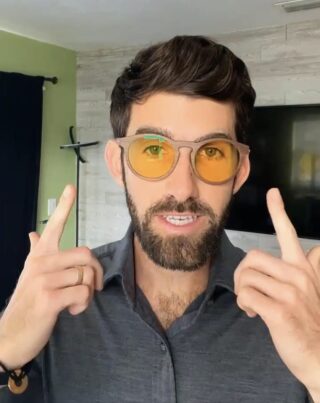At times, the line between madness and brilliance becomes blurred.
Take this image of me, for instance, captured in the glow of the evening:
When the line between madness and brilliance becomes blurred… Familiar? Here I’m, in the evening’s glow:

In that picture, I’m wearing what we commonly refer to as “blue-blocking glasses,”. But the more apt term would be ‘circadian light harmonizing glasses, from Vivarays’ (I’ll delve deeper into why this term resonates better, later on). These glasses have become an integral part of my evening routine, faithfully worn after sunset.
Why?
Well, these glasses filter out all blue and green light.
Devin, “What exactly are blue and green lights? And why should I consider blocking them?”
Let me enLIGHTen you about, well, LIGHT.
When light, including the blue and green spectrum, enters your eyes, it profoundly influences your health and well-being.
Light isn’t just for vision, and your eyes aren’t merely cameras; they transcend this purpose, for they are gateways to a realm beyond sight.
Light has a big job in controlling how your body works, and your eyes are like a gateway that lets light give instructions to your body’s cells, organs and hormones.
And here’s why this topic is worth your attention:
Putting on these glasses after sunset is about eliminating the harmful light frequencies when they are most damaging.
This simple act can yield a multitude of benefits:
- Increased daytime energy
- Deeper sleep
- Enhanced mental clarity
- Feeling calm and relaxed
- Overall improved sense of well-being.
How do these blue-blocking glasses contribute to improving your sleep, energy and mood?
That’s the intriguing part I intend to unfold in this blog post. Get ready.
I’ll start by sharing the story behind how and why I embraced this seemingly peculiar (yet necessary) habit. Then, we will dive headfirst into the scientific realm of blue and green light (primarily for the science enthusiasts among us).
Let’s set forth!
The Light Spectrum and Human Evolution: Embracing the Necessity of Blue-Blocking Glasses
Let’s delve into the fascinating realm of blue and green light by exploring what is known as the “light spectrum.”
At first glance, the term “light spectrum” may seem intimidating. However, we’re all familiar with it—just think of the colors of the rainbow:
The beautiful array of colors in a rainbow
Those vibrant hues constitute what we refer to as the “visible light spectrum.”
When we talk about the visible light spectrum, we’re referring to the colors of light that can be seen by the human eye. As you can observe, the primary colors present in a rainbow are:
- Violet: 🟪
- Blue: 🔵
- Green: 🟢
- Yellow: 🟡
- Orange: 🟠
- Red: 🔴
In this article, our primary focus will be on the blue and green lights.
As human beings, we have evolved to be exposed to specific frequencies of light at different times of the day
To illustrate this, let’s take a glimpse at an African tribe
These remarkable individuals live harmoniously with the sun.
When the sun rises in the morning, they awaken, and several hours after sunset, they go to sleep.
Their daily rhythm is beautifully synchronized with the natural light cycles.
The light spectrum of the sun at sunrise or sunset differs significantly from that at noon.
During sunrise, a wealth of red light and infrared light (invisible heat) reaches the Earth, while blue and green light is less prominent. This serene morning light gently awakens us, boosting our alertness and focus.
As the sun ascends higher in the sky, the intensity of blue and green light reaching the Earth’s surface increases. These particular frequencies of light invigorate us, helping us stay sharp and attentive in the early hours of the day.
But as the sun begins its descent towards the horizon, something magical happens. The blue and green light gradually fade away, making room for the warm tones of orange, red, and eventually the darkness of the night. Remember these colors because they will make more sense later.
This natural shift in the light environment isn’t just a muse for poets; it subconsciously guides our bodies, signaling that it’s time to wind down and prepare for a restorative night’s sleep.
But here’s the unfortunate reality: if you’re living in our modern tech-centric world, chances are you’re missing out on this vital signal, THE KEY for a peaceful deep, rejuvenating sleep.
Have you ever found yourself glued to your phone, scrolling through social media or responding to emails right before bedtime?
Have you indulged in your favorite TV show or documentary late into the evening?
Have you turned on artificial light bulbs in your home when the world outside is cloaked in darkness?
If you answered yes to any of these questions, you’re sabotaging your sleep and well-being by missing out on nature’s signal of darkness.
But it doesn’t have to be that way. Fortunately, there is an easy fix, and you don’t have to live in a cave or disconnect from the modern world to reclaim your sleep.
Thanks to high-quality blue-blocking glasses, you can filter out the disruptive blue and green light that tricks your brain into thinking it’s high noon, even in the darkest hours of the night.
You see, most artificial light sources surrounding you, from your phone screens to those light bulbs at home, emit substantial amounts of blue and green light.
And here’s the catch: throughout evolution, our bodies weren’t designed to be exposed to these wavelengths after sunset.
They belong to the daytime spectrum and send signals to our body that it’s still daytime, throwing our sleep into holy mess
Remember the African tribe example I mentioned earlier?
Due to their natural lifestyle, these tribes experience blue and green light during the day, with minimal exposure to artificial light sources (aside from campfires).
Their campfires emit only red (and infrared) light, which does not disrupt their sleep patterns.
But we can’t turn back time or rewind our evolution. We’re part of a “modern” society that bombards us with blue and green lights, no matter where we go.
Smartphones, TV screens, and artificial lighting are constant sources of light that were completely absent throughout most of human history. – Let that sink into your awareness.
That’s why wearing high-quality blue-blocking glasses is not a luxury. It’s a necessity of our lifetime.
These glasses act as your sleep superheroes, shielding your eyes from the disruptive effects of blue and green light and helping you reclaim the restful sleep that your body needs.
So, how do these blue light-blocking glasses work and why are they the ultimate solution to protect your sleep?
Before we go into this part, which will be in your inbox next week, I want you to go back through this part and reread it. To make sure you understand the foundations of Light importance.



